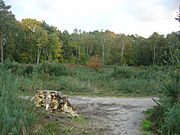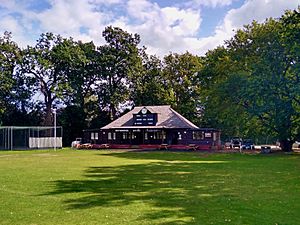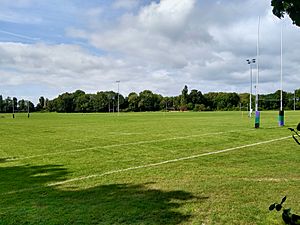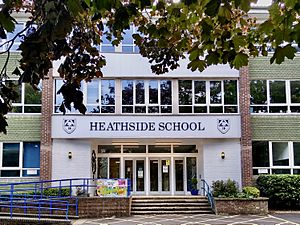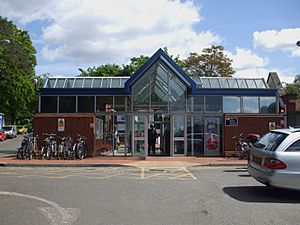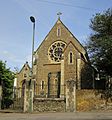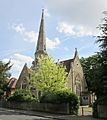Weybridge facts for kids
Quick facts for kids Weybridge |
|
|---|---|
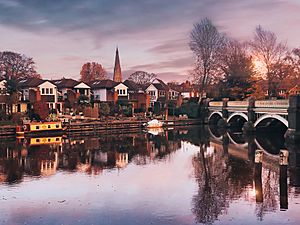 The Old Bridge on the River Wey |
|
| Area | 13.73 km2 (5.30 sq mi) |
| Population | 15,449 (2011 census) or 29,837 (Built-up Area, which extends to Byfleet) |
| • Density | 1,125/km2 (2,910/sq mi) |
| OS grid reference | TQ0764 |
| • London | 27 km (17 mi) north east |
| Civil parish |
|
| District |
|
| Shire county | |
| Region | |
| Country | England |
| Sovereign state | United Kingdom |
| Post town | Weybridge |
| Postcode district | KT13 |
| Dialling code | 01932 |
| Police | Surrey |
| Fire | Surrey |
| Ambulance | South East Coast |
| EU Parliament | South East England |
| UK Parliament |
|
Weybridge is a town in the Borough of Elmbridge in Surrey, England, around 17 mi (27 km) southwest of central London. The settlement is recorded as Waigebrugge and Weibrugge in the 7th century and the name derives from a crossing point of the River Wey, which flows into the River Thames to the north of the town centre. The earliest evidence of human activity is from the Bronze Age. During the Anglo-Saxon and medieval periods, Weybridge was held by Chertsey Abbey.
In the 1530s, Henry VIII constructed Oatlands Palace to the north of the town centre, which he intended to be the residence of his fourth wife, Anne of Cleves. He married Catherine Howard there in July 1540 and the palace remained a royal residence until the Civil War. The buildings were demolished in the early 1650s and a new mansion, Oatlands House, was constructed to the west of Weybridge later the same century. Prince Frederick, Duke of York and Albany owned the mansion in the 18th century.
The town began to expand beyond its medieval footprint in the early 19th century, catalysed by the initial breakup of the Oatlands House estate, the enclosure of Weybridge Heath and the opening of the railway station in 1838. The developer, W. G. Tarrant, was responsible for the construction of housing on St George's Hill in the first half of the 20th century.
The world's first purpose-built racing circuit was constructed at Brooklands in 1907. The track hosted the first British Grand Prix in 1926 and was used by Malcolm Campbell to develop his final land speed record car, Campbell-Railton Blue Bird. Throughout the 20th century, Brooklands was an important location for the aerospace industry and aircraft developed and tested there included the Sopwith Camel, the Wellington bomber and the Hurricane fighter. Vickers established a factory at the circuit in 1915 and aircraft manufacturing continued at the site until 1988.
Contents
History
Weybridge lay within the Elmbridge hundred.
Weybridge appears in Domesday Book of 1086 as Webrige and Webruge held partly by Chertsey Abbey; partly by an Englishman from the abbey; and partly by Herfrid from the conqueror's brother, the Bishop of Bayeux. Its domesday assets were: 6 hides; 1½ ploughs, 32 acres (130,000 m2) of meadow, wood worth 9 hogs. It rendered £4 per year to it feudal system overlords. It was much smaller than today's post town, and about one quarter of the size of neighbouring Walton.
In 1235 Henry III granted to William son of Daniel Pincerna, for his homage and service, two mills on the River Wey, one above the 'bridge of Wey,' and the other at Feyreford (a place which no longer exists) at an annual rent of five silver marks.
Until the late 18th century Weybridge was as a very small village with a river crossing, seed milling to make flour and nurseries would continue to provide the major source of home-grown income until the 20th century but no tanneries, major coaching houses, shops, markets, forges or gunpowder works are documented for example in the medieval period. The earliest monuments on the tower wall of St James's C of E Church are 15th century plaques, and the Church was rebuilt in 1848 with a south aisle added in 1864. In 1537 the south-west of Walton on Thames extra-territorially a manor house affiliated to Weybridge on what was a border of Weybridge and Walton, Oatlands Palace, was built by Henry VIII, which was where he married his fifth wife Catherine Howard. When it was demolished in 1650, bricks from its walls helped to line the then new Wey Navigation canal.
In 1571 commissioners were appointed to report on the condition of the bridge across the Wey. They stated that for some years it had been so decayed as to be "unsafe for passengers, and that it was now ruinous...if the queen (Elizabeth I of England) should be at her house at Oatlands and the waters should rise, 'as often they do,' she could not pass to her forest to hunt". It was accordingly ordered that a new bridge – a horse-bridge like the last – should be built, wood being used for its construction, as stonework would be too costly. The expense was to be borne by the queen, as the land on either side belonged to her.
St. George's Hill was the site of the Diggers' Commune in the 1640s.
At the bottom of Monument Hill, within the definition of the town centre is a monument to the Duchess of York, erected by public subscription in 1820 from the remains of the original Seven Dials Monument that stood in St. Martin's Lane, London until 1773. The Duchess is buried in St. James's Churchyard.
In the 19th century Oatlands broke away from the parish of Walton on Thames to become a village in its own right, eventually to have three places of worship. Influenced by the secondary manor of Weybridge, the forerunner of Oatlands Palace (at which time the heart of the grounds became the Oatlands Park Hotel), the post town adopted Oatlands as its only village in the 19th century.
The entomologist, Horace Donisthorpe, visited Weybridge Heath to investigate the ant colony.
Weybridge grew into a commuter town with the advent of the fast train link into London Waterloo and a lot of 'new' houses have been built around the Oatlands Park and Broadwater Lake area.
Plant life
In Weybridge Heath, many rare species of insects (particularly ants), rare birds and insectivorous plant have been recorded. The heath was allowed to become vastly overgrown in recent years, but recently Surrey Wildlife Trust invoked a scrub clearance plan in an attempt to restore this valuable habitat.
In popular culture
- In H. G. Wells' classic novel The War of the Worlds (1897), Weybridge was the location of a battle in which a Martian fighting machine was destroyed. The title of chapter 12 of the book is: "What I saw of the destruction of Weybridge and Shepperton". The battle also featured in the track "The Artilleryman and the Fighting Machine" from Jeff Wayne's Musical Version of The War of the Worlds (1978), and in a graphic novel by Ian Edginton and D'Israeli (2006), adapted from Wells' book. It was also the location that a ship carrying refugees from Southern England, sailed out of the Harbour protected by several vessels including the ship "Thunderchild". It was this ship that was involved in the battle and also managed to destroy one of the Martian Fighting Machines (only to be destroyed itself)
- In John Wyndham's novel The Kraken Wakes (1953), the main characters are stopped in their attempt to reach Cornwall on a dinghy, through a flooded England, in the whereabouts of Weybridge.
- In Salman Rushdie's novel The Satanic Verses (1998), Weybridge was referred to by one of Saladin Chamcha's interrogators as his place of residence and also (incorrectly) as that of The Beatles (in fact only John Lennon and Ringo Starr lived in Weybridge for short periods).
- In Cosmos Epic' s song "Dorking", he mentions Weybridge when naming specific towns, namely Weybridge, Walton , Hersham, Addlestone, Compton and Dorking.
Demography and housing
| Output area | Population | Households | % Owned outright | % Owned with a loan | hectares |
|---|---|---|---|---|---|
| Weybridge North | 4,347 | 1,914 | 27 | 37 | 233 |
| Weybridge South | 4,600 | 2,088 | 31 | 33 | 202 |
| St George's Hill | 6,502 | 2,567 | 33 | 40 | 938 |
| Regional average | 35.1 | 32.5 |
| Output area | Detached | Semi-detached | Terraced | Flats and apartments | Caravans/temporary/mobile homes | Shared between households |
|---|---|---|---|---|---|---|
| Weybridge North | 439 | 435 | 398 | 642 | 0 | 0 |
| Weybridge South | 499 | 328 | 336 | 908 | 2 | 15 |
| St George's Hill | 1,152 | 379 | 340 | 696 | 0 | 0 |
Across the South East Region, 28% of homes were detached houses and 22.6% were apartments.
Wikisource link
- What I Saw of the Destruction of Weybridge and Shepperton ("The War of the Worlds", Chapter 12)
Sport and leisure
Cricket
Weybridge Cricket Club was formed in 1924, by the merger of two existing clubs, the oldest of which was founded before 1870. Cricket is thought to have been played on Weybridge Green since at least 1814. In 1921, the UDC improved the ground by levelling the surface and the surrounding banking.
Weybridge Vandals Cricket Club traces its origins to two clubs formed in the early 20th century. Brownacres Cricket Club was founded in 1938, but changed its name to University Vandalls CC in 1953. In 1975, it merged with the Olinda CC, which had been formed in 1924.
Golf
St George's Hill Golf Course was designed by the architect Harry Colt and the first 18 holes opened in 1913. The course was constructed on land owned by W. G. Tarrant, who intended the course to complement the surrounding housing development. The original club house was burnt down in March 1920 and was replaced the same year. The future Edward VIII was president of the club from 1934–35 and his brother the future George VI was also a member. The German Foreign Minister, Joachim von Ribbentrop, visited the club in 1937. A second 18-hole course, also designed by Colt, was opened in 1929, but was reduced to nine holes in 1946.
Silvermere Golf Course was designed by Neil Coles and Brian Huggett and opened in 1976. The 18-hole course surrounds Silvermere Lake, where Barnes Wallace tested prototypes of his bouncing bomb. Both the 17th and 18th holes require golfers to play the ball across the surface of the lake.
Rowing
Weybridge Rowing Club was founded in 1881 and moved to its current premises, adjacent to Thames Lock, in 1910. Women were first admitted as members in 1910. Weybridge Ladies Amateur Rowing Club was founded by Amy Gentry in 1926. Weyfarers Rowing Club for recreational rowers was founded in September 2000.
The Weybridge Community Regatta, organised by Weybridge Rowing Club, takes place on the Desborough Cut each summer. The club has hosted the Weybridge Silver Sculls head since 1956. The race takes place on a 3,000 m (3,300 yd) course on the Thames. The Weybridge Veterans' Head is held each year in March and includes events for juniors as well as veterans.
Rugby
Weybridge Vandals RFC was founded in 1932 for members of the University of London. It was initially known as "London University Vandals RFC" and played its home matches at Motspur Park. A vulture taking off with wings raised was adopted as the club symbol. The club moved to the premises of a former private zoo on Desborough Island in 1932 and, in 2003, changed its name to Weybridge Vandals RFC to reflect the location of its home ground.
Shooting
Weybridge Rifle and Pistol Club was opened in 1901. Initially the range was at Brooklands Farm, but relocated in 1906 to allow for the construction of the racing circuit. In 2021, the club has a 100-yard outdoor range for .22 calibre rifles and a 25-yard outdoor air gun range.
Tennis
St George's Hill Lawn Tennis Club was opened in 1913. It covers 16 acres (6.5 ha) and has 33 courts, of which 13 are grass courts. It also offers four squash courts and facilities for badminton and table tennis.
Weybridge Lawn Tennis Club, in Walton Lane, offers five outdoor courts.
Education
Early schools
The first recorded school in Weybridge was a Dame School for 12 children, founded c. 1650 in Baker Street. A charity school for poor children was founded in Weybridge in 1732 by Elizabeth Hopton and was incorporated into a new Parochial School in 1813. A second small parochial school was founded on the Oatlands estate in 1862 and was enlarged in 1874 to accommodate 201 children.
Maintained schools
There are several Primary Schools in Weybridge. St Charles Borromeo Catholic Primary School was founded in Heath Road in 1881. It educates around 210 pupils aged from 4 to 11. Cleves School, in Oatlands Avenue, became an academy in November 2010. St James Church of England Primary School is in Grotto Road.
Heathside School, in Brooklands Lane, is a co-educational secondary school for students aged 11 to 18. It opened in 1966.
Independent school
St George's College Junior School is a coeducational Catholic school for pupils aged 3 to 11. It moved from the main school campus in Addlestone to Thames Street in 2000. The site, to the north of Weybridge town centre, had previously been occupied by a school for girls, founded in 1898 by the nuns of Les Dames de St Maur.
Further education
Brooklands College opened in 1951 as the Brooklands Technical College. Its Weybridge campus is built around the former Brooklands House, a Grade II-listed building, which was once the home of the Locke-King family. The mansion was originally constructed in 1860, but was rebuilt by the architect, Reginald Blomfield, in a Queen Anne style in 1891.
Brooklands College merged with Spelthorne College in Ashford in 2007. It now operates across two campuses and educates over 1,600 students. Higher education courses are offered in association with Oxford Brookes and Kingston Universities.
Transport
Bus
Weybridge is linked by a number of bus routes to surrounding towns and villages in north Surrey and south west London. Operators serving the town include Arriva, Diamond Bus, the East Surrey Rural Transport Partnership and Falcon Buses.
Train
Weybridge railway station is to the south of the town centre. It is managed by South Western Railway, which operates all services. Trains run to London Waterloo via Clapham Junction and to Woking.
The non-tidal section of the River Thames is navigable between Lechlade in Gloucestershire and Teddington Lock. The navigation authority is the Environment Agency. The River Wey is navigable from Weybridge to Godalming and the navigation authority is the National Trust.
National cycle route
National Cycle Route 4, which links London to Fishguard, passes through Weybridge.
Long-distance footpaths
The Thames Path runs along the south bank of the River Thames, to the north of the town centre.
Notable residents
- Thomas Hopsonn (1643–1717) – Vice-admiral, moved to Weybridge in 1702. He built Vigo House and is buried in St James' Church.
- David Colyear, 1st Earl of Portmore (c. 1656-1730) – army officer and Governor of Gibraltar, lived at Portmore Park
- Fanny Kemble (1809–1893) – author, actor and anti-slavery campaigner, lived at Eastlands, Brooklands Road
- Benjamin Scott (1814–1892) – Chamberlain of the City of London, lived at Heath House (now named Lorimar House), founded the Congregational chapel (now Weybridge United Reformed Church)
- George Fergusson Wilson (1822-1902) – industrial chemist, lived at Weybridge from 1863 until his death
- Lionel Smith Beale (1828-1906) – physician and microscopist, lived in Weybridge from 1885 to 1904
- Elizabeth Dawes (1864-1954) – classical scholar and teacher, lived and taught in Weybridge from 1889 until her death
- George May, 1st Baron May (1871-1946) – financial expert and civil servant, lived at Eyot House
- John Fozard (1928-1996) – aeronautical engineer and designer of the Hawker Siddeley Harrier, lived at St George's Hill
- Colin Davis (1927–2013) – conductor, was born in the town.
- John Lennon (1940-1980) – musician, lived at Kenwood, St George's Hill from 1964 to 1968
- Ringo Starr (b. 1940) – musician, lived at St George's Hill from 1965 to 1968
- Theo Paphitis (b. 1959) – businessman, entrepreneur and TV personality
Images for kids
-
Aero Clubhouse, Brooklands Museum
See also
 In Spanish: Weybridge para niños
In Spanish: Weybridge para niños



